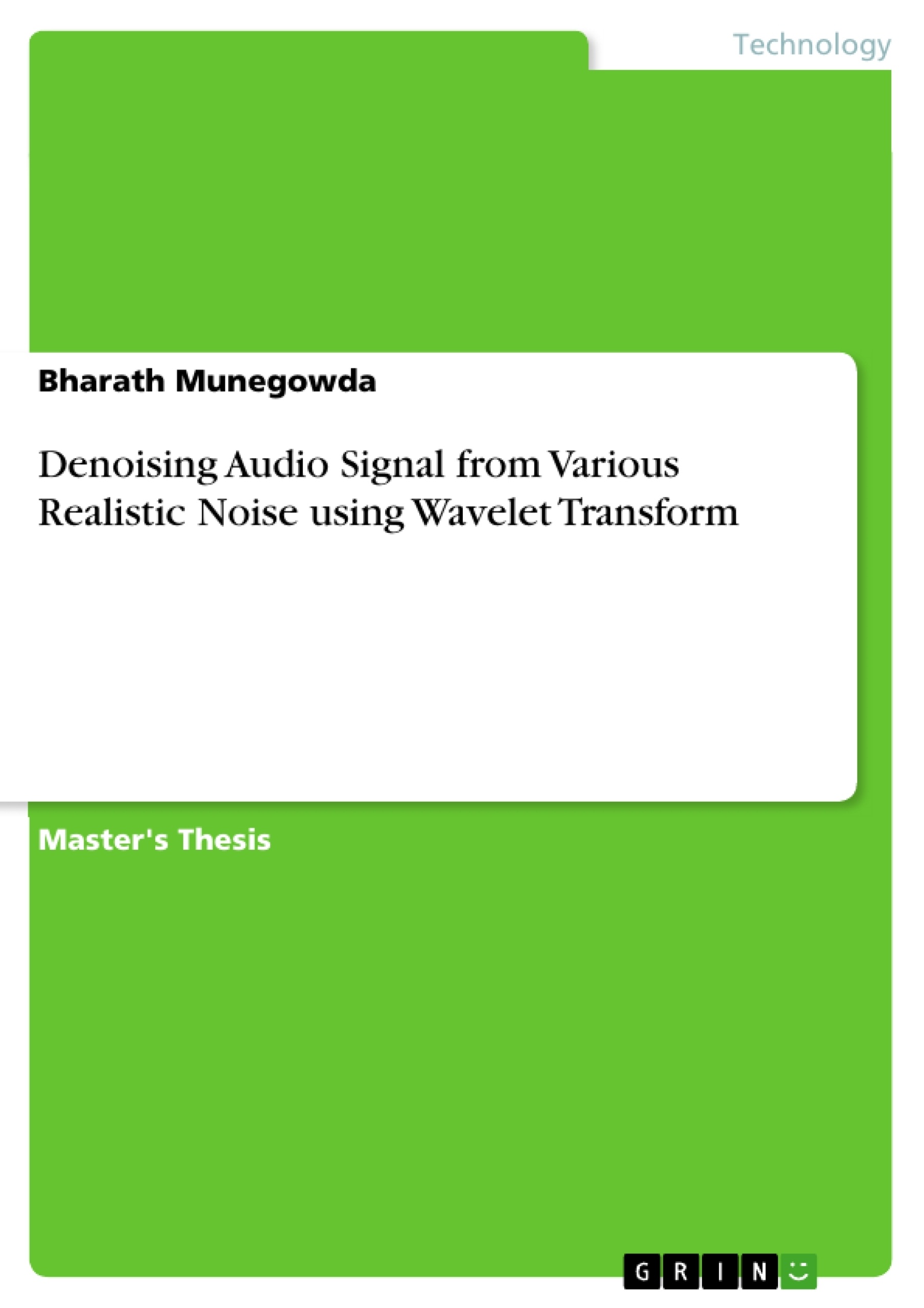Audio signals are more frequently polluted with various types of realistic noises. So, periods ago in order to reduce the noise level, some filtering approach will be used. But, presently there are many transform based techniques to estimate the noisy audio signal. One of the transform technique known as wavelet transform will be used for denoising an audio signal from realistic noise. Predominantly, the objective of this proposed research is to characterise discrete wavelet transform (DWT) towards denoising a one dimensional audio signal from common realistic noise. Moreover, the idea is to implement the audio signal denoising techniques such as decomposition, thresholding (soft) and reconstruction in the MATLAB simulation software, and elaborate a comparative analysis based on choice of wavelet transform over Fourier transform. Likewise, for the different level of decomposition, signal to noise (SNR) will be estimated .To sum up, in this research, different circumstances has been measured to elect best wavelet function and its level, based on its response of signal to noise ratio (SNR) in denoising audio signal.
Table of Contents
- Chapter 1: Introduction and Objectives of the Project
- 1.1 Introduction
- 1.2 Project Summary
- Chapter 2: Theoretical Examination of Wavelet Transform
- 2.1 Principle of Wavelet Transform
- 2.2 Development of Wavelet Transform
- 2.3 Wavelet transform
- 2.3.1 Continuous wavelet transform
- 2.3.2 Discrete wavelet transform
- 2.4 Multiresolution Analysis (MRA)
- 2.4.1 Philosophy of Multiresolution Analysis
- 2.4.2 Features of MRA
- 2.4.3 Properties of Scale and Time- Frequency Resolution
- Chapter 3: Literature review
- 3.1 Overview
- 3.2 Short time Fourier transform
- 3.3 From Fourier Transform to Wavelet Transform
- 3.4 Comparison of wavelet transforms with Fourier transform
- 3.5 Wavelet Functions (WF)
- 3.6 Applications of Wavelet Transform
- 3.7 Audio Signal Denoising Using Wavelet Transform
- 3.8 Examples of Wavelet Based Noise Analysis
- Chapter 4: Audio Signal Denoising Using Wavelet Transform
- 4.1 Digital Audio Signal
- 4.2 Audio Signal Denoising
- 4.2.1 Decomposition
- 4.2.2 Threshold selection
- 4.2.3 Reconstruction
- Chapter 5: Experimental Results
- 5.1 Noise Analysis Using MATLAB
- 5.2 Critical examination of results
Objectives and Key Themes
This project aims to investigate the effectiveness of the Discrete Wavelet Transform (DWT) in denoising audio signals corrupted by realistic noise. The study focuses on characterizing the DWT for this purpose and comparing its performance to the Fourier transform. The project also explores the implementation of DWT-based denoising techniques, including decomposition, thresholding, and reconstruction, using MATLAB.
- The efficacy of the Discrete Wavelet Transform (DWT) for audio signal denoising.
- Comparative analysis of the DWT and Fourier transform for audio signal denoising.
- Implementation of DWT-based denoising techniques in MATLAB.
- Impact of different levels of decomposition on signal-to-noise ratio (SNR) in audio signal denoising.
- Identification of optimal wavelet functions and decomposition levels for effective audio denoising.
Chapter Summaries
Chapter 1 provides an introduction to the project, outlining its objectives and summarizing its scope. Chapter 2 delves into the theoretical foundation of wavelet transform, exploring its principles, development, and different types, including continuous and discrete wavelet transforms. It also examines the concept of multiresolution analysis (MRA) and its significance in wavelet transform. Chapter 3 presents a literature review, discussing the short-time Fourier transform, comparing it with the wavelet transform, and exploring the applications of wavelet transform in various fields. It also examines the use of wavelet transform for audio signal denoising and provides examples of wavelet-based noise analysis. Chapter 4 focuses on the practical application of wavelet transform for audio signal denoising. It discusses the process of digital audio signal denoising, including decomposition, threshold selection, and reconstruction. Chapter 5 presents the experimental results obtained from MATLAB simulations, analyzing the effectiveness of the DWT for denoising audio signals with different types of noise. It also examines the critical aspects of the results and their implications.
Keywords
This research focuses on the application of wavelet transform, specifically the Discrete Wavelet Transform (DWT), for denoising audio signals. Key concepts include audio signal processing, realistic noise, denoising techniques, decomposition, thresholding, reconstruction, signal-to-noise ratio (SNR), wavelet function selection, and comparative analysis with the Fourier transform. The study utilizes MATLAB for implementation and analysis, contributing to the field of digital signal processing and audio engineering.
- Quote paper
- Bharath Munegowda (Author), 2016, Denoising Audio Signal from Various Realistic Noise using Wavelet Transform, Munich, GRIN Verlag, https://www.grin.com/document/334133



